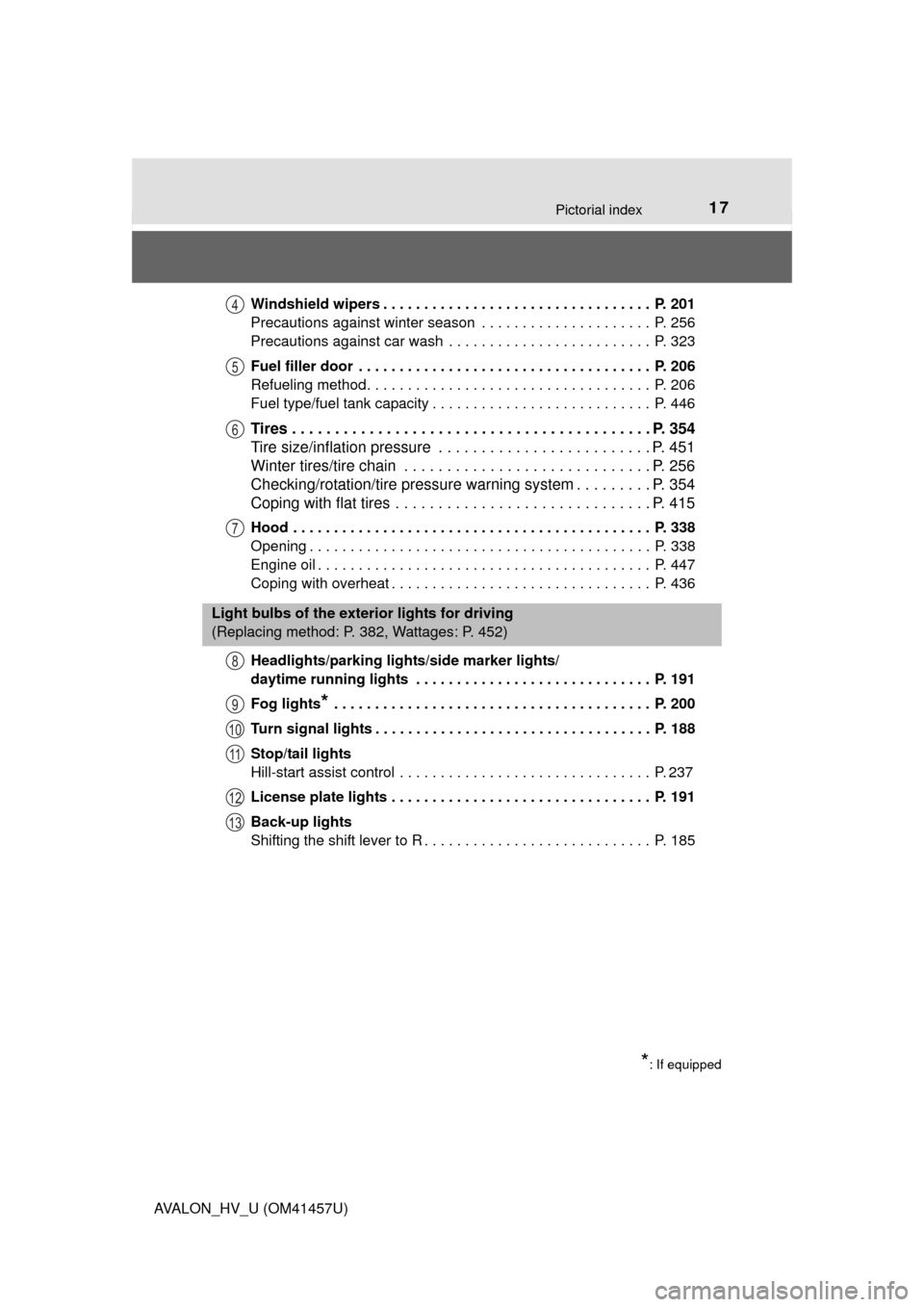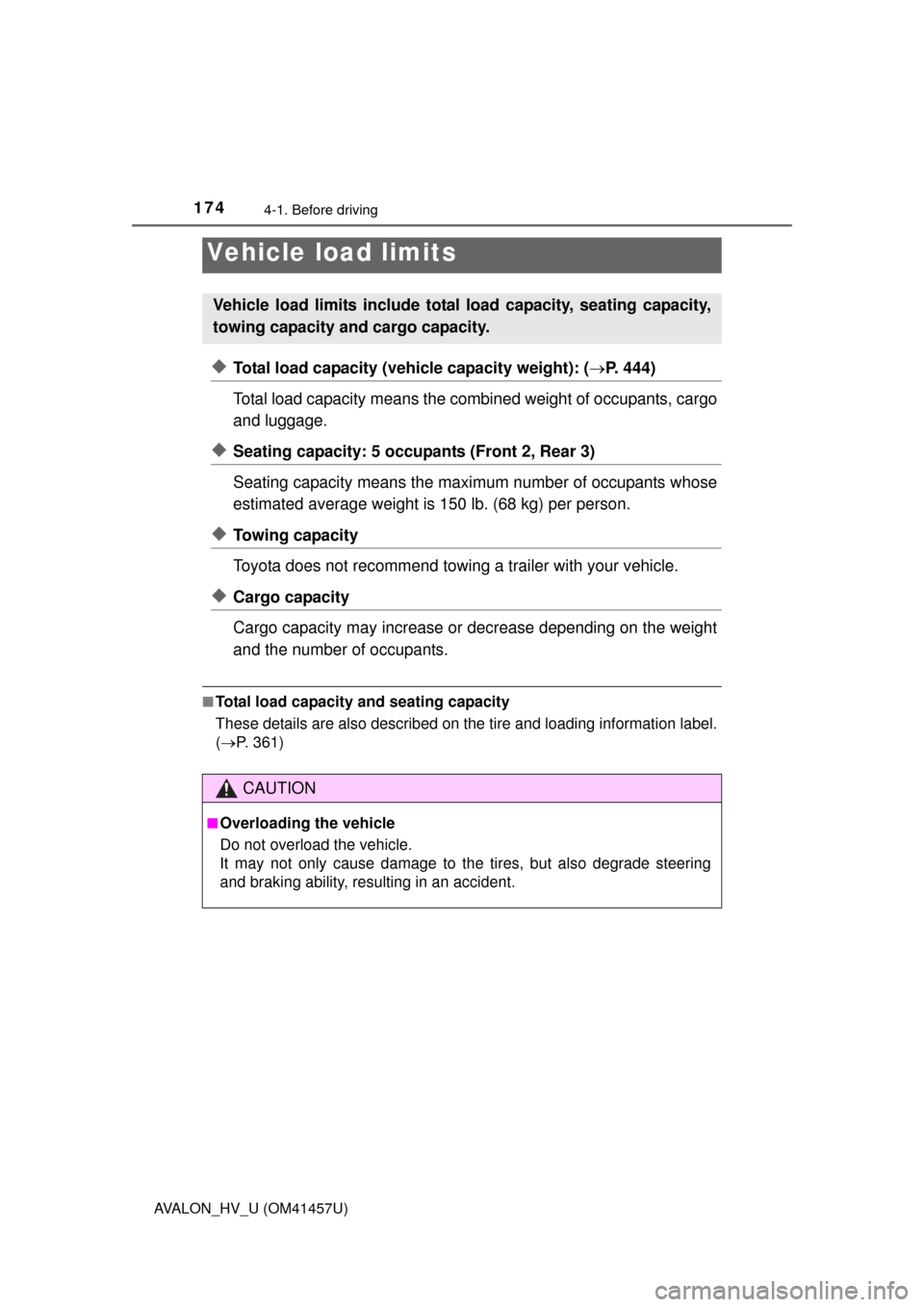2015 TOYOTA AVALON HYBRID tires
[x] Cancel search: tiresPage 5 of 504

5
1
8 7
6
5
4
3
2
9
AVALON_HV_U (OM41457U)6-1. Maintenance and care
Cleaning and protecting the vehicle exterior .......... 322
Cleaning and protecting the vehicle interior ........... 325
6-2. Maintenance Maintenance requirements ................... 328
General maintenance ........ 330
Emission inspection and maintenance (I/M)
programs ......................... 334
6-3. Do-it-yourself maintenance
Do-it-yourself service precautions ..................... 335
Hood.................................. 338
Positioning a floor jack ...... 339
Engine compartment ......... 341
12-volt battery ................... 350
Tires .................................. 354
Tire inflation pressure........ 361
Wheels .............................. 364
Air conditioning filter .......... 367
Electronic key battery ........ 369
Checking and replacing fuses ............................... 371
Light bulbs ......................... 382 7-1. Essential information
Emergency flashers ........... 398
If your vehicle has to be stopped in an
emergency....................... 399
7-2. Steps to take in an emergency
If your vehicle needs to be towed ...................... 400
If you think something is wrong............................... 403
If a warning light turns on or a warning buzzer
sounds ............................. 404
If a warning message is displayed ......................... 414
If you have a flat tire .......... 415
If the hybrid system will not start ........................... 427
If the shift lever cannot be shifted from P ............. 429
If the electronic key does not operate properly ........ 430
If the 12-volt battery is discharged ....................... 432
If your vehicle overheats......................... 436
If the vehicle becomes stuck ................................ 440
6Maintenance and care7When trouble arises
Page 17 of 504

17Pictorial index
AVALON_HV_U (OM41457U)Windshield wipers . . . . . . . . . . . . . . . . . . . . . . . . . . . . . . . . . P. 201
Precautions against winter season . . . . . . . . . . . . . . . . . . . . . P. 256
Precautions against car wash . . . . . . . . . . . . . . . . . . . . . . . . . P. 323
Fuel filler door . . . . . . . . . . . . . . . . . . . . . . . . . . . . . . . . . . . . P. 206
Refueling method . . . . . . . . . . . . . . . . . . . . . . . . . . . . . . . . . . . P. 206
Fuel type/fuel tank capacity . . . . . . . . . . . . . . . . . . . . . . . . . . . P. 446
Tires . . . . . . . . . . . . . . . . . . . . . . . . . . . . . . . . . . . . . . . . . . P. 354
Tire size/inflation pressure . . . . . . . . . . . . . . . . . . . . . . . . . P. 451
Winter tires/tire chain . . . . . . . . . . . . . . . . . . . . . . . . . . . . . P. 256
Checking/rotation/tire pressure warning system . . . . . . . . . P. 354
Coping with flat tires . . . . . . . . . . . . . . . . . . . . . . . . . . . . . . P. 415
Hood . . . . . . . . . . . . . . . . . . . . . . . . . . . . . . . . . . . . . . . . . . . . P. 338
Opening . . . . . . . . . . . . . . . . . . . . . . . . . . . . . . . . . . . . . . . . . . P. 338
Engine oil . . . . . . . . . . . . . . . . . . . . . . . . . . . . . . . . . . . . . . . . . P. 447
Coping with overheat . . . . . . . . . . . . . . . . . . . . . . . . . . . . . . . . P. 436
Headlights/parking lights/side marker lights/
daytime running lights . . . . . . . . . . . . . . . . . . . . . . . . . . . . . P. 191
Fog lights
* . . . . . . . . . . . . . . . . . . . . . . . . . . . . . . . . . . . . . . . P. 200
Turn signal lights . . . . . . . . . . . . . . . . . . . . . . . . . . . . . . . . . . P. 188
Stop/tail lights
Hill-start assist control . . . . . . . . . . . . . . . . . . . . . . . . . . . . . . . P. 237
License plate lights . . . . . . . . . . . . . . . . . . . . . . . . . . . . . . . . P. 191
Back-up lights
Shifting the shift lever to R . . . . . . . . . . . . . . . . . . . . . . . . . . . . P. 185
4
5
6
7
Light bulbs of the exterior lights for driving
(Replacing method: P. 382, Wattages: P. 452)
*: If equipped
8
9
10
11
12
13
Page 161 of 504

1614-1. Before driving
4
Driving
AVALON_HV_U (OM41457U)
Make sure that the parking brake is set and shift the shift lever to D.
Gently depress the accelerator pedal.
Release the parking brake.
■When starting off on a uphill
The hill-start assist control is available. ( P. 237)
■ Driving in the rain
●Drive carefully when it is raining, because visibility will be reduced, the win-
dows may become fogged-up, and the road will be slippery.
● Drive carefully when it starts to rain, because the road surface will be espe-
cially slippery.
● Refrain from driving at high speeds in the rain, as there may be a layer of
water between the tires and the road surface, preventing the steering and
brakes from operating properly.
■ Engine speed while driving
In the following conditions, the engine speed may become high while driving.
This is due to automatic up-shifting control or down-shifting implementation to
meet driving conditions. It does not indicate sudden acceleration.
●The vehicle is judged to be driving uphill or downhill
● When the accelerator pedal is released
■ Breaking in your new Toyota
To extend the life of the vehicle, observing the following precautions is recom-
mended:
●For the first 186 miles (300 km):
Avoid sudden stops.
● For the first 621 miles (1000 km):
• Do not drive at extremely high speeds.
• Avoid sudden acceleration.
• Do not drive continuously in low gears.
• Do not drive at a constant speed for extended periods.
Starting off on a steep uphill
1
2
3
Page 164 of 504

1644-1. Before driving
AVALON_HV_U (OM41457U)
CAUTION
Observe the following precautions.
Failure to do so may result in death or serious injury.
■When driving the vehicle
● During normal driving, do not turn off the hybrid system. Turning the hybrid
system off while driving will not cause loss of steering or braking control,
however, power assist to the steering will be lost. This will make it more
difficult to steer smoothly, so you should pull over and stop the vehicle as
soon as it is safe to do so.
In the event of an emergency, such as if it becomes impossible to stop the
vehicle in the normal way: P. 399
● Use engine braking (downshift) to maintain a safe speed when driving
down a steep hill.
Using the brakes continuously may cause the brakes to overheat and lose
effectiveness. ( P. 185)
● Do not adjust the positions of the steering wheel, the seat, or the inside or
outside rear view mirrors while driving.
Doing so may result in a loss of vehicle control.
● Always check that all passengers’ arms, heads or other parts of their body
are not outside the vehicle.
● Do not drive in excess of the speed limit. Even if the legal speed limit per-
mits it, do not drive over 85 mph ( 140 km/h) unless your vehicle has high-
speed capability tires. Driving over 85 mph (140 km/h) may result in tire
failure, loss of control and possible injury. Be sure to consult a tire dealer
to determine whether the tires on y our vehicle are high-speed capability
tires or not before driving at such speeds.
Page 174 of 504

1744-1. Before driving
AVALON_HV_U (OM41457U)
◆Total load capacity (vehicle capacity weight): (P. 444)
Total load capacity means the combined weight of occupants, cargo
and luggage.
◆Seating capacity: 5 occupants (Front 2, Rear 3)
Seating capacity means the maxi mum number of occupants whose
estimated average weight is 150 lb. (68 kg) per person.
◆Towing capacity
Toyota does not recommend towing a trailer with your vehicle.
◆Cargo capacity
Cargo capacity may increase or decrease depending on the weight
and the number of occupants.
■Total load capacity and seating capacity
These details are also described on the tire and loading information label.
( P. 361)
Vehicle load limits
Vehicle load limits include total load capacity, seating capacity,
towing capacity and cargo capacity.
CAUTION
■Overloading the vehicle
Do not overload the vehicle.
It may not only cause damage to the tires, but also degrade steering
and braking ability, resu lting in an accident.
Page 235 of 504

2354-5. Using the driving support systems
4
Driving
AVALON_HV_U (OM41457U)
CAUTION
■The ABS does not operate effectively when
● The limits of tire gripping performance have been exceeded (such as
excessively worn tires on a snow covered road).
● The vehicle hydroplanes while driving at high speed on wet or slick roads.
■ Stopping distance when the ABS is operating may exceed that of nor-
mal conditions
The ABS is not designed to shorten the vehicle’s stopping distance. Always
maintain a safe distance from the vehicle in front of you, especially in the
following situations:
● When driving on dirt, gravel or snow-covered roads
● When driving with tire chains
● When driving over bumps in the road
● When driving over roads with potholes or uneven surfaces
■ TRAC may not operat e effectively when
Directional control and power may not be achievable while driving on slip-
pery road surfaces, even if the TRAC system is operating.
Drive the vehicle carefully in conditions where stability and power may be
lost.
■ When the VSC is activated
The slip indicator light flashes. Always drive carefully. Reckless driving may
cause an accident. Exercise particular care when the indicator light flashes.
■ When the TRAC/VSC syst ems are turned off
Be especially careful and drive at a speed appropriate to the road condi-
tions. As these are the systems to help ensure vehicle stability and driving
force, do not turn the TRAC/VSC systems off unless necessary.
Page 236 of 504

2364-5. Using the driving support systems
AVALON_HV_U (OM41457U)
CAUTION
■Replacing tires
Make sure that all tires are of the specified size, brand, tread pattern and
total load capacity. In addition, make sure that the tires are inflated to the
recommended tire inflation pressure level.
The ABS, TRAC and VSC systems will not function correctly if different tires
are installed on the vehicle.
Contact your Toyota dealer for further information when replacing tires or
wheels.
■ Handling of tires and the suspension
Using tires with any kind of problem or modifying the suspension will affect
the driving assist systems, and may cause a system to malfunction.
Page 255 of 504

2554-6. Driving tips
4
Driving
AVALON_HV_U (OM41457U)■
Air conditioning
Use the air conditioning only when
necessary. Doing so can help
control excessive gasoline consumption.
In summer: In high temperatures, use the recirculated air mode.
Doing so will help to reduce the burden on the air conditioner and
reduce fuel cons umption as well.
In winter: Because the gasoline eng ine will not automatically cut out
until the gasoline engine and the in terior of the vehicle are warm, it
will consume fuel. Also, fuel consumption can be improved by
avoiding overuse of the heater.
■Checking tire inflation pressure
Make sure to check the tire infl ation pressure frequently. Improper
tire inflation pressure can cause poor fuel consumption.
Also, as snow tires can cause large amounts of friction, their use on
dry roads can lead to poor fuel co nsumption. Use a tire that is
appropriate for the season.
■Luggage
Carrying heavy luggage can lead to poor fuel consumption. Avoid
carrying unnecessary luggage. Insta lling a large roof rack can also
cause poor fuel consumption.
■Warming up before driving
Since the gasoline engine starts up and cuts out automatically
when cold, warming up the engine is unnecessary. Moreover, fre-
quently driving short distances will cause the engine to repeatedly
warm up, which can lead to poor fuel consumption.